|
News Archive: Feb. 1-28 |

|
'Deep impact' of pulsar plunging into gas ring
Astronomers have witnessed a never-seen-before event in observations by the European Space Agency's XMM-Newton spacecraft - a collision between a pulsar and a ring of gas around a neighboring star.
 FULL STORY FULL STORY
 |  |

|
 |
Hubble's largest galaxy portrait displays Pinwheel
Giant galaxies weren't assembled in a day. Neither was this Hubble Space Telescope image of the face-on Pinwheel Galaxy. The image is the largest and most detailed photo of a spiral galaxy ever released from Hubble.
 FULL STORY FULL STORY
 |  |

|
 |
Shuttle fuel tank en route; Schedule options debated
The shuttle Discovery's modified external tank may arrive at the Kennedy Space Center Wednesday, a day early, to kick off the final push toward launch of the second post-Columbia shuttle mission. But agency officials say unfinished foam work, testing and resolution of other on-going issues will make it extremely difficult for NASA to meet its May target launch date.
 FULL STORY FULL STORY
 |  |

|
 |
OTHER HEADLINES Additional stories today
|
 |
Lockheed-built GPS satellites mark 50 years on orbit -- The fleet of Global Positioning System (GPS) Block 2R satellites designed and built by Lockheed Martin to significantly enhance the overall performance of the GPS constellation has now accumulated 50 years of successful in-orbit operations.

Boeing gets contract to process shuttle radar data -- Boeing has received a $3.5 million follow-on task order from the National Geospatial-Intelligence Agency (NGA) to enhance the digital topographic data collected by the space shuttle Endeavour.

Alcatel to build Turksat 3A telecommunication satellite -- Alcatel Alenia Space has announced that it has signed a turnkey contract with Turkish operator Turksat AS, for the construction and the in-orbit delivery of a new powerful telecommunication satellite, Turksat 3A.
|
 |
Mimas and the giant
A small and battered reminder of the solar system's violent youth, the ice moon Mimas hurtles around its gas giant parent, Saturn. At 247 miles across, Mimas is simply dwarfed by the immensity of Saturn. The planet is more than 150 times as wide as the moon.
 FULL STORY FULL STORY
 |  |

|
 |
A blast to chase
Possibly similar to what our own Milky Way looks like, Messier 100 is a grand design spiral galaxy that presents an intricate structure, with a bright core and two prominent arms, showing numerous young and hot massive stars as well as extremely hot knots. The galaxy was the target of the European Southern Observatory to perform detailed observations of the newly found supernova SN 2006X.
 FULL STORY FULL STORY
 |  |

|
 |
Spacecraft detects new kind of cosmic explosion
Scientists using NASA's Swift satellite have detected a new kind of cosmic explosion. The event appears to be a precursor to a supernova, which is expected to reach peak brightness in one week.
 FULL STORY FULL STORY
 |  |

|
 |
Satellite back after 'near death experience'
NASA's Far Ultraviolet Spectroscopic Explorer astronomy satellite is back in full operation, its aging onboard software control system rejuvenated and its mission extended by enterprising scientists and engineers after a near death experience in December 2004.
 FULL STORY FULL STORY
 |  |
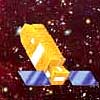
|
 |
Mars Reconnaissance Orbiter nears arrival
NASA's $720 million Mars Reconnaissance Orbiter mission faces a make-or-break milestone March 10 when it fires its main engines for nearly a half hour, slowing the craft enough to slip into orbit around the red planet. If the burn doesn't work or is too short, MRO will race past Mars and on into a useless orbit around the sun.
 FULL STORY FULL STORY
 |  |

|
 |

Additional coverage for subscribers:
 VIDEO:
MARS ARRIVAL PREVIEW NEWS BRIEFING DIAL-UP | BROADBAND VIDEO:
MARS ARRIVAL PREVIEW NEWS BRIEFING DIAL-UP | BROADBAND
 AUDIO:
LISTEN TO THE NEWS CONFERENCE FOR IPOD AUDIO:
LISTEN TO THE NEWS CONFERENCE FOR IPOD
 MORE: MARS RECONNAISSANCE ORBITER COVERAGE MORE: MARS RECONNAISSANCE ORBITER COVERAGE
 SUBSCRIBE NOW SUBSCRIBE NOW

|
New Hubble images offer best view of Pluto, moons
Anxiously awaited follow-up observations with NASA's Hubble Space Telescope have confirmed the presence of two new moons around the distant planet Pluto. The moons were first discovered by Hubble in May 2005, but the science team probed even deeper into the Pluto system last week to look for additional satellites and to characterize the orbits of the moons.
 FULL STORY FULL STORY
 |  |

|
 |
Ariane 5 scrubbed again
Today's rescheduled launch of the Ariane 5 rocket with two European communications satellites has been postponed to resolve a concern with one of the payloads. A launch attempt earlier this week was scrubbed by ground equipment problems that required the vehicle be rolled back to its hangar from the launch pad.
 MISSION STATUS CENTER MISSION STATUS CENTER
 |  |
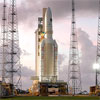
|
 |
Milky Way map reveals millions of unseen objects
Nearly 400 years after Galileo determined the wispy Milky Way actually comprises myriad individual stars, scientists using NASA's Rossi X-ray Timing Explorer have done the same for the "X-ray Milky Way."
 FULL STORY FULL STORY
 |  |

|
 |
Rhea's wisps in color
Bright, wispy markings stretch across a region of darker terrain on Saturn's moon Rhea. In this extreme false-color view, the roughly north-south fractures occur within strips of material that are a different color from the surrounding cratered landscape. Subtle differences in the surface composition or grain sizes making up the icy soil could explain the origin of these markings.
 FULL STORY FULL STORY
 |  |

|
 |
Hot alien world is the closest directly detected
A NASA-led team of astronomers have used NASA's Spitzer Space Telescope to detect a strong flow of heat radiation from a toasty planet orbiting a nearby star. The findings allowed the team to "take the temperature" of the planet.
 FULL STORY FULL STORY
 |  |

|
 |
Weather satellite leaves launch pad for health check
After spending eight months on the launch pad, the newest U.S. weather observatory has been detached from its Delta 4 rocket booster and returned to the hangar for precautionary health checks before liftoff is attempted again.
 FULL STORY FULL STORY
 |  |

|
 |
Lockheed plan would assemble CEV in Florida
Lockheed Martin announced Wednesday, in partnership with the State of Florida, its plans to locate final assembly and testing of the Crew Exploration Vehicle at Kennedy Space Center if the company wins the CEV competition.
 FULL STORY FULL STORY
 |  |

|
 |
Pluto's new moons likely born with Charon
A team of U.S. scientists led by Dr. S. Alan Stern of Southwest Research Institute, concludes that two newly discovered small moons of Pluto were very likely born in the same giant impact that gave birth to Pluto's much larger moon, Charon. The team also argues that other, large binary Kuiper Belt Objects may also frequently harbor small moons, and that the small moons orbiting Pluto may generate debris rings around Pluto.
 FULL STORY FULL STORY
 |  |

|
 |
OTHER HEADLINES Additional stories today
|
 |
Land Launch to carry AMOS-3 -- Space International Services and Sea Launch Company are pleased to announce the award of a firm launch contract with Israel Aircraft Industries, Ltd., utilizing the Land Launch system. A Zenit-3SLB vehicle will launch the AMOS-3 communications satellite.

Lockheed gets lightning mapper contract -- The Lockheed Martin Advanced Technology Center has been awarded a $2 million, 12-month contract by the NASA Goddard Space Flight Center to proceed to the formulation phase for the Geostationary Lightning Mapper instrument that will fly on NOAA GOES-R Series environmental satellites.
|
 |
Japanese infrared space observatory goes into orbit
A new infrared telescope was put in orbit by Japan Tuesday to begin an 18-month mission to conduct a comprehensive all-sky survey that should detect light from up to ten million objects scattered throughout the Universe.
 FULL STORY FULL STORY
 |  |

|
 |
Deep X-ray surveys reveal black hole population
Data from X-ray observatory surveys show that black holes are much more numerous and evolved differently than researchers would have expected, according to a Penn State astronomer.
 FULL STORY FULL STORY
 |  |

|
 |
Mars orbiter studies possible aurorae
The European Space Agency's Mars Express spacecraft has seen more evidence that aurorae occur over the night side of Mars, especially over areas of the surface where variations in the magnetic properties of the crust have been detected.
 FULL STORY FULL STORY
 |  |

|
 |
Stardust samples under study in laboratory
Scientists at the University of Chicago are among the first ever to analyze cometary dust delivered to Earth via spacecraft. Scientists routinely examine extraterrestrial material that has fallen to Earth as meteorites, but never before NASA's Stardust mission have they had access to verified samples of a comet.
 FULL STORY FULL STORY
 |  |
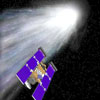
|
 |
Amateurs spot 10th planet
A group of amateur astronomers has used a telescope at McDonald Observatory to make the first "through-the-Eyepiece" sighting of the tenth planet, an object orbiting the Sun in the Kuiper Belt, far beyond Pluto.
 FULL STORY FULL STORY
 |  |

|
 |
OTHER HEADLINES Additional stories today
|
 |
Boeing to begin work on 4th Wideband Gapfiller Satellite -- Boeing has received a $148 million contract from the U.S. Air Force to begin work on the fourth satellite in the Wideband Gapfiller Satellite (WGS) system, a 13-kilowatt spacecraft based upon Boeing's 702 satellite model.
|
 |
Cosmic ray mystery solved
When Voyager 1 finally crossed the "termination shock" at the edge of interstellar space in December 2004, space physicists anticipated the long-sought discovery of the source of anomalous cosmic rays. These cosmic rays, among the most energetic particle radiation in the solar system, are thought to be produced at the termination shock - the boundary at the edge of the solar system where the million-mile-per-hour solar wind abruptly slows. A mystery unfolded instead when Voyager data showed 20 years of predictions to be wrong.
 FULL STORY FULL STORY
 |  |

|
 |
Spirit hits a home run
NASA's Mars Exploration Rover Spirit arrived at "Home Plate," a feature that, when seen from orbit, looks like the home plate of a baseball diamond. Home Plate is a roughly circular feature about 260 feet in diameter that might be an old impact crater or volcanic feature. The Spirit team has been eager to get to Home Plate and has been enjoying distant views of the feature and a curious "bathtub ring" of light-colored materials along its edges.
 FULL STORY FULL STORY
 |  |

|
 |
Stellar candidates for habitable worlds
In the search for life on other worlds, scientists can listen for radio transmissions from stellar neighborhoods where intelligent civilizations might lurk or they can try to actually spot planets like our own in habitable zones around nearby stars. Either approach is tricky and relies on choosing the right targets for scrutiny out of the many thousands of nearby stars in our galactic neighborhood.
 FULL STORY FULL STORY
 |  |
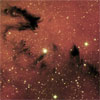
|
 |
Japan launches air traffic, weather spacecraft
Air traffic controllers and meteorologists in Japan have a new tool at their disposal after Saturday's successful launch of a new satellite that will conduct a dual mission to serve both communities for the next decade.
 FULL STORY FULL STORY
 |  |

|
 |
NASA plans to park space shuttle Atlantis in 2008
With just 17 or so flights left on the shuttle manifest before the program is terminated in 2010, NASA's three remaining orbiters can only expect to fly about five missions each. As it turns out, NASA now plans to retire Atlantis in 2008, after five flights, rather than put it through a required overhaul and to "fly out" the remaining half-dozen missions on the manifest with Discovery and Endeavour.
 FULL STORY FULL STORY
 |  |

|
 |
NASA studies shuttle engine seals, contamination
NASA now plans to ship the next external fuel tank to the Kennedy Space Center ahead of schedule and the shuttle Discovery's commander said Friday the astronauts remain optimistic about launching in May on the second post-Columbia mission. But a variety of technical issues remain on the table, including wind tunnel tests to show fuel tank changes will work as expected, an ice and debris analysis and, most recently, main engine seal leaks and metallic contamination in the main propulsion system.
 FULL STORY FULL STORY
 STS-121 FLIGHT PLAN STS-121 FLIGHT PLAN
 KEY PERSONNEL CHART KEY PERSONNEL CHART
 MISSION QUICK-LOOK: Page 1 | Page 2 MISSION QUICK-LOOK: Page 1 | Page 2
 |  |

|
 |

Additional coverage for subscribers:
 VIDEO:
CREW PRESS CONFERENCE ON FEB. 17 DIAL-UP | BROADBAND VIDEO:
CREW PRESS CONFERENCE ON FEB. 17 DIAL-UP | BROADBAND
 MORE:STS-121 VIDEO COVERAGE MORE:STS-121 VIDEO COVERAGE
 SUBSCRIBE NOW SUBSCRIBE NOW

|
Pulsar is on its way out
The Milky Way's fastest observed pulsar is speeding out of the galaxy at more than 670 miles a second, propelled largely by a kick it received at its birth 2.5 million years ago. At this speed, you could travel from London to New York in five seconds.
 FULL STORY FULL STORY
 |  |
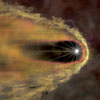
|
 |
The invisible galaxies that could not hide
Astronomers, using the unique capabilities offered by the high-resolution spectrograph on European Southern Observatory's Very Large Telescope, have found a metal-rich hydrogen cloud in the distant universe. The result may help to solve the missing metal problem and provides insight on how galaxies form.
 FULL STORY FULL STORY
 |  |

|
 |
Greenland ice loss doubles in past decade, NASA says
The loss of ice from Greenland doubled between 1996 and 2005, as its glaciers flowed faster into the ocean in response to a generally warmer climate, according to a NASA/University of Kansas study being published Friday. The study concludes the changes to Greenland's glaciers in the past decade are widespread, large and sustained over time. They are progressively affecting the entire ice sheet and increasing its contribution to global sea level rise.
 FULL STORY FULL STORY
 |  |

|
 |
Violent galaxies found smothered in crushed glass
NASA's Spitzer Space Telescope has observed a rare population of colliding galaxies whose entangled hearts are wrapped in tiny crystals resembling crushed glass. This is the first time silicate crystals have been detected in a galaxy outside of our own.
 FULL STORY FULL STORY
 |  |

|
 |
New satellite launched for DISH Network subscribers
With a booming burst of fire and smoke, a Sea Launch Zenit 3SL rocket began its journey toward orbit from the tranquil Pacific Ocean Wednesday on a mission to deploy a communications satellite that will become part of DISH Network's space-based broadcasting system.
 FULL STORY FULL STORY
 MISSION STATUS CENTER MISSION STATUS CENTER
 |  |

|
 |
Astronomers find new kind of cosmic object
An team of astronomers using the CSIRO Parkes radio telescope in eastern Australia has found a new kind of cosmic object - small, compressed 'neutron stars' that show no activity most of the time but once in a while spit out a single burst of radio waves.
 FULL STORY FULL STORY
 |  |

|
 |
Cassini orbiter listens to lightning storm on Saturn
Imagine an electrical storm larger than the continental United States in which the lightning bolts are more than 1,000 times stronger than conventional lightning, and you'll have a good idea of the lightning storm -- the strongest of its kind ever seen -- that scientists are tracking at Saturn with the Cassini spacecraft.
 FULL STORY FULL STORY
 |  |

|
 |
Spacecraft spots powerful Saturn storm at night
Following the recent detection of Saturnian radio bursts by NASA's Cassini spacecraft that indicated a rare and powerful atmospheric storm, imaging scientists have spotted the storm in an unlikely fashion: they looked for it in the dark.
 FULL STORY FULL STORY
 |  |

|
 |
Progress report: NASA begins testing CLV concept
Testing is underway by engineers at NASA's Marshall Space Flight Center to lay the foundation for developing the Crew Launch Vehicle, the agency's future launch vehicle system.
 FULL STORY FULL STORY
 |  |

|
 |

Additional coverage for subscribers:
 VIDEO:
NARRATED ANIMATION OF NEW ROCKETS PLAY | Free preview VIDEO:
NARRATED ANIMATION OF NEW ROCKETS PLAY | Free preview
 VIDEO:
NARRATED ANIMATION OF LUNAR LANDER PLAY | Free preview VIDEO:
NARRATED ANIMATION OF LUNAR LANDER PLAY | Free preview
 VIDEO:
LUNAR ARCHITECTURE PLAN DIAL-UP | BROADBAND VIDEO:
LUNAR ARCHITECTURE PLAN DIAL-UP | BROADBAND
 VIDEO:
QUESTION AND ANSWER SESSION DIAL-UP | BROADBAND VIDEO:
QUESTION AND ANSWER SESSION DIAL-UP | BROADBAND
 SUBSCRIBE NOW SUBSCRIBE NOW

|
OTHER HEADLINES Additional stories today
|
 |
Contract kicks off Soyuz operations phase in Kourou -- Arianespace and the Russian space agency Roscosmos have signed the supply contract for the first four Soyuz launch vehicles to be launched from the Guiana Space Center (Kourou, French Guiana) starting in 2008.
|
 |
System found where planets may orbit backward
Astronomers studying a disk of material circling a still-forming star inside our Galaxy have found a tantalizing result -- the inner part of the disk is orbiting the protostar in the opposite direction from the outer part of the disk.
 FULL STORY FULL STORY
 |  |

|
 |
Cassini looks at dim duo
This close pairing of Saturn's moons Janus and Epimetheus shows the two moons at "high phase," meaning that only a thin sliver of sunlit terrain is visible on each moon. Portions of each are also lit feebly by reflected light from Saturn. In this Cassini image, Janus is at top and Epimetheus is below.
 FULL STORY FULL STORY
 |  |

|
 |
A closer look at Saturn's moon Telesto
These Cassini views show surface features and color variation on the Trojan moon Telesto. The smooth surface of this Saturn moon suggests that it is covered with a mantle of fine, dust-sized icy material.
 FULL STORY FULL STORY
 |  |

|
 |
Sounds near middle 'C' rock stars to death
Scientists have made the astonishing discovery that sound might drive supernovae explosions. Their computer simulations say that dying stars pulse at audible frequencies -- for instance, at about the F-note above middle C -- for a split second before they blow up.
 FULL STORY FULL STORY
 |  |

|
 |
How to steal a million stars?
Based on observations with European Southern Observatory's Very Large Telescope, a team of Italian astronomers reports that the stellar cluster Messier 12 must have lost to our Milky Way galaxy close to one million low-mass stars.
 FULL STORY FULL STORY
 |  |

|
 |
Peeking behind the veil of Venus to study its weather
The planet Venus is best known for the thick layers of clouds that veil its surface from view by telescopes on Earth. But the veil has holes, and a New Mexico State University scientist plans on using a solar telescope to peer through them to study the weather on Venus.
 FULL STORY FULL STORY
 |  |

|
 |
'Man in the moon' origin may have been found
Ohio State University planetary scientists have found the remains of ancient lunar impacts that may have helped create the surface feature commonly called the "man in the moon."
 FULL STORY FULL STORY
 |  |
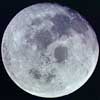
|
 |
New Horizons: Cruising from Earth to Jupiter
New Horizons continues to do well in flight - three weeks down and 492 to go. More than 99 percent of the journey to the Pluto system is still ahead. The mission leader offers this update on the spacecraft that aims to be the first to explore Pluto and the Kuiper Belt.
 FULL STORY FULL STORY
 |  |

|
 |
NASA preparing oxygen generation system for ISS
NASA is preparing to launch a new oxygen generation system to the International Space Station that uses water to generate breathable oxygen for crew members. The system will be installed in a cargo compartment later this month for a possible May launch aboard the space shuttle Discovery.
 FULL STORY FULL STORY
 |  |
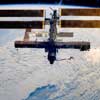
|
 |
Spitzer finds hints of mega solar systems out there
NASA's Spitzer Space Telescope has identified two huge "hypergiant" stars circled by monstrous disks of what might be planet-forming dust. The findings surprised astronomers because stars as big as these were thought to be inhospitable to planets.
 FULL STORY FULL STORY
 |  |

|
 |
Industry uses NASA wind tunnels to design airplanes
NASA-developed wind tunnel technology is being used by the aviation industry to perfect new airplane designs throughout the entire development process.
 FULL STORY FULL STORY
 |  |
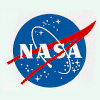
|
 |
Hubble snaps images of a pinwheel-shaped galaxy
Looking like a child's pinwheel ready to be set a spinning by a gentle breeze, this dramatic spiral galaxy is one of the latest viewed by NASA's Hubble Space Telescope. Stunning details of the face-on spiral galaxy, cataloged as NGC 1309, are captured in this color image.
 FULL STORY FULL STORY
 |  |

|
 |
Rough and tumble Hyperion
The tumbling and irregularly shaped moon Hyperion hangs before Cassini in this image taken during a distant encounter in December. This still image is part of a sequence of 40 images taken over about two hours as Cassini sped past the icy moon.
 FULL STORY FULL STORY
 |  |

|
 |
OTHER HEADLINES Additional stories today
|
 |
ILS announces Nimiq, Sirius contracts -- International Launch Services announced three awards, including the Canadian Nimiq 4 for Telesat and a spot for a Sirius Satellite Radio spacecraft, it kicks off its participation this week in a satellite industry conference in Washington, D.C.
|
 |
NASA budget supports up to 17 space shuttle flights
By sharply reducing the growth of space science and other NASA programs over the next five years, NASA managers hope to erase a projected multi-billion dollar shortfall in the shuttle budget, permitting up to 17 missions between now and the program's retirement in 2010, including a possible flight to service the Hubble Space Telescope. Only two flights are expected this year, one in May and the other late this summer, as NASA struggles to complete its recovery from the Columbia disaster and finish a major overhaul of the shuttle Endeavour.
 FULL STORY FULL STORY
 |  |

|
 |

Additional coverage for subscribers:
 VIDEO:
NASA '07 BUDGET NEWS CONFERENCE: VIDEO:
NASA '07 BUDGET NEWS CONFERENCE:
DIAL-UP: part 1 and part 2 | BROADBAND: part 1 and part 2
 AUDIO:
LISTEN TO THE BUDGET BRIEFING FOR IPOD AUDIO:
LISTEN TO THE BUDGET BRIEFING FOR IPOD
 SUBSCRIBE NOW SUBSCRIBE NOW

|
Detection of hot halo gets theory out of hot water
Scientists using NASA's Chandra X-ray Observatory have detected an extensive halo of hot gas around a quiescent spiral galaxy. This discovery is evidence that galaxies like our Milky Way are still accumulating matter from the gradual inflow of intergalactic gas.
 FULL STORY FULL STORY
 |  |

|
 |
OTHER HEADLINES Additional stories today
|
 |
JSAT selects Proton rocket to launch JCSAT-11 satellite -- JSAT Corporation of Japan has contracted with International Launch Services (ILS) for launch of its JCSAT-11 satellite on a Proton Breeze M vehicle in 2007. The companies announced the deal Monday at the Satellite 2006 conference in Washington, D.C. Financial terms were not disclosed.
|
 |
Boeing prepares to reunite its fractured Delta team
After a contentious three-month strike that put hundreds of Delta rocket machinists on the picket line, those workers begin returning to work Monday, as Boeing officials try to soothe bitter feelings from the lengthy labor dispute and finally resume the stalled launch schedule.
 FULL STORY FULL STORY
 |  |

|
 |
Castaway spacesuit radio experiment still alive
Reports that the amateur radio equipment tucked aboard the discarded Russian spacesuit launched by spacewalking astronauts Friday had stopped transmitting have proven premature, project officials said Saturday, amid reports from around the world of hearing very weak signals from the orbiting object.
 FULL STORY [Posted: Saturday] FULL STORY [Posted: Saturday]
 |  |

|
 |

Additional coverage for subscribers:
 VIDEO:
SPACESUIT THROWN OVERBOARD PLAY VIDEO:
SPACESUIT THROWN OVERBOARD PLAY
 VIDEO:
LONGER VIDEO OF SPACESUIT TUMBLING AWAY PLAY VIDEO:
LONGER VIDEO OF SPACESUIT TUMBLING AWAY PLAY
 VIDEO:
LATER FOOTAGE OF SUIT WITH EARTH AS BACKDROP PLAY VIDEO:
LATER FOOTAGE OF SUIT WITH EARTH AS BACKDROP PLAY
 VIDEO:
MISSION CONTROL SAYS SUITSAT STOPS TRANSMITTING PLAY VIDEO:
MISSION CONTROL SAYS SUITSAT STOPS TRANSMITTING PLAY

 VIDEO:
SPACEWALK PREVIEW BRIEFING DIAL-UP | BROADBAND 1 & 2 VIDEO:
SPACEWALK PREVIEW BRIEFING DIAL-UP | BROADBAND 1 & 2
 AUDIO:
LISTEN TO THE BRIEFING FOR IPOD AUDIO:
LISTEN TO THE BRIEFING FOR IPOD
 MORE: EXPEDITION 12 VIDEO INDEX MORE: EXPEDITION 12 VIDEO INDEX
 SUBSCRIBE NOW SUBSCRIBE NOW

|
Spacewalkers run into bolt problem; SuitSat falls silent
Space station commander Bill McArthur and flight engineer Valery Tokarev completed a five-hour, 43-minute spacewalk Friday night, but problems "safing" a protective cable cutter on a key station component will complicate already planned repair work by the crew of the next shuttle mission. And in a disappointment to amateur radio enthusiasts, an old Russian spacesuit that was dumped overboard as part of an amateur radio project stopped transmitting shortly after its release.
 FULL STORY [Posted: Friday] FULL STORY [Posted: Friday]
 PREVIEW STORY PREVIEW STORY
 |  |

|
 |
Ice exists on surface of comet, but most lies deeper
Scientists for Deep Impact, the University of Maryland-led NASA mission that made history when it smashed into a comet this past July 4th, have added another first to their growing list: the first finding of water ice on the surface of a comet.
 FULL STORY FULL STORY
 |  |

|
 |

Additional coverage for subscribers:
 VIDEO:
DEEP IMPACT SMASHES INTO COMET PLAY VIDEO:
DEEP IMPACT SMASHES INTO COMET PLAY
 VIDEO:
NARRATION OF IMPACTOR'S FINAL IMAGES PLAY VIDEO:
NARRATION OF IMPACTOR'S FINAL IMAGES PLAY
 VIDEO:
IMPACT MOVIES FROM MOTHERSHIP (NARRATED) PLAY VIDEO:
IMPACT MOVIES FROM MOTHERSHIP (NARRATED) PLAY
 VIDEO:
RIDE ALONG AS THE IMPACTOR SLAMS INTO TARGET PLAY VIDEO:
RIDE ALONG AS THE IMPACTOR SLAMS INTO TARGET PLAY
 VIDEO:
IMPACT PICTURES EXPLAINED BY COMET EXPERT PLAY VIDEO:
IMPACT PICTURES EXPLAINED BY COMET EXPERT PLAY
 VIDEO:
"DEEP IMPACT: THE MISSION" MOVIE PLAY VIDEO:
"DEEP IMPACT: THE MISSION" MOVIE PLAY
 VIDEO:
"DIGGING OUT THE SCIENCE" PLAY VIDEO:
"DIGGING OUT THE SCIENCE" PLAY
 SUBSCRIBE NOW SUBSCRIBE NOW

|
Surfing the seas of space to catch atmospheric wave
A study by NASA and university scientists is shedding new light on a mysterious, cyclical wave in Earth's atmosphere that at times profoundly affects our planet's weather and climate.
 FULL STORY FULL STORY
 |  |
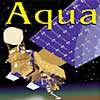
|
 |
Trojan asteroid Patroclus: Really a comet in disguise?
Like the hollow wooden horse hiding Greek warriors in the Trojan War, could an entire population of asteroids be masquerading as comets? Observations of the binary asteroid Patroclus taken at the W. M. Keck Observatory on Mauna Kea have astronomers wondering if asteroids caught in the gravitationally neutral zone of the Sun-Jupiter system might actually be ancient comets and space dust.
 FULL STORY FULL STORY
 |  |

|
 |
Solar system's new planet is larger than Pluto
Claims that the solar system has a tenth planet are bolstered by the finding by a group led by Bonn astrophysicists that this alleged planet is bigger than Pluto. This makes it the largest solar system object found since the discovery of Neptune in 1846.
 FULL STORY FULL STORY
 |  |
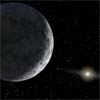
|
 |
OTHER HEADLINES Additional stories today
|
 |
Construction of Telstar 11N satellite begins -- Loral Skynet has announced that construction of Telstar 11N, a powerful new multi-region Ku-band communications satellite, has begun at Space Systems/Loral in Palo Alto, Calif. When it enters service in the second quarter of 2008, Telstar 11N will provide service across four different geographic beams in each of North and Central America, Europe, Africa and the maritime Atlantic Ocean Region.

Eutelsat selects alliance for new W2M satellite -- Eutelsat Communications has selected a new industrial partnership combining the expertise of EADS Astrium and ISRO, the Indian Space Research Organisation, to build a telecommunications satellite called W2M.

EADS Astrium to supply Algeria's ALSAT-2 -- EADS Astrium has signed a contract with the Algerian National Space Technology Centre for the development of the ALSAT-2 system, which consists of two optical observation satellites. ALSAT-2 is the first Earth observation satellite system from the AstroSat100 family to be built using the Myriade platform.
|
 |
Boeing Delta rocket workers vote to end strike
The striking Boeing machinists at Cape Canaveral and Vandenberg Air Force Base have voted to accept a new contract offer, ending a three-month strike that grounded the Delta rocket fleet. Union members at the Delta engineering hub in Huntington Beach, California also voted in favor of the three-year contract, officials said Wednesday.
 EARLIER STORY EARLIER STORY
 |  |

|
 |
|
Read our earlier news archive page.
|



